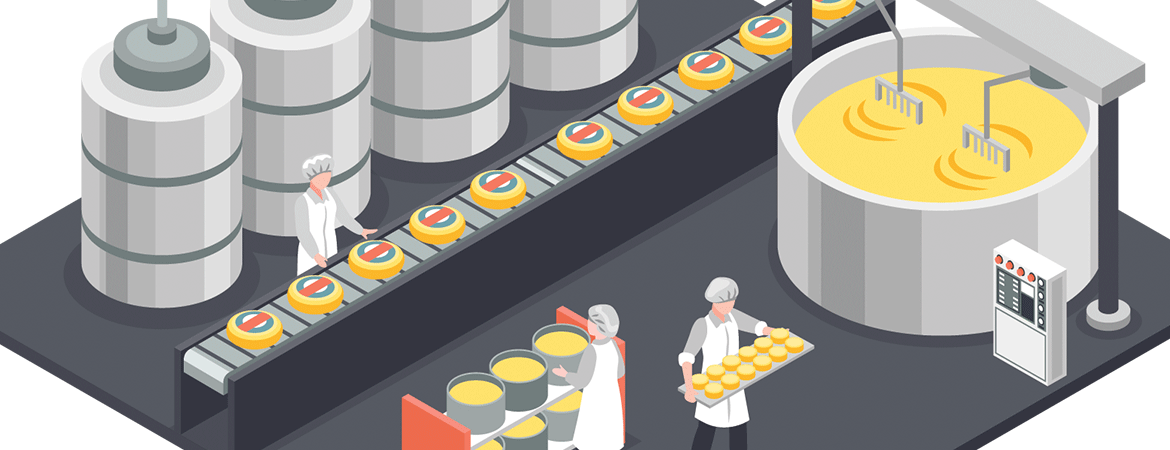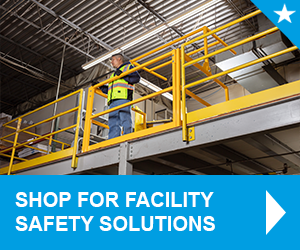
US food and beverage manufacturers play an important role in the economy, and not just because they keep us all fed. There are an estimated 1.4 million people who work within the food and beverage manufacturing industry. While providing employment opportunities helps build strong communities, these workers may be exposed to risks while on the job. Of all these risks, falls are of particular concern. There are specific OSHA requirements for fall protection, designed to provide business owners and safety managers guidance for protecting key hazard areas, such as setting up a modular guard rail to protect machinery on the manufacturing floor or installing mezzanine gates to prevent unauthorized access to elevated areas.
You’ll have to evaluate your facility before deciding which fall protection equipment you need. Below we will identify some of the most common fall hazards in food and beverage processing facilities and discuss the most effective ways to mitigate them to ensure your workers stay as safe as possible on the job.
Common Fall Hazards Within Food & Beverage Manufacturing Plants
The first step you must take to protect workers from falls is to identify the fall hazards that they will be exposed to. This is a crucial step that cannot be avoided, otherwise, someone may get hurt and your organization will face severe consequences such as OSHA fines and penalties, lost productivity, and potential damage to your company’s reputation. Perform a thorough inspection of your facility to ensure you’re following OSHA requirements for fall protection including, but not limited to:
Elevated Working/Walking Surfaces/Mezzanines
In order to maximize usable space, food, and beverage facilities are often multi-level operations. Mezzanines and catwalks allow workers to access vertical space, which increases the potential for production. However, unprotected edges of these elevated surfaces are a serious fall hazard. In fact, anytime workers are expected to perform their duties 4′ above a previous level, they must be protected from falls.
A common OSHA-compliant form of fall protection used on elevated working/walking surfaces is permanent or modular guard rail. For mezzanines specifically, where forklifts raise pallets regularly, and employees are moving and storing items, specially designed mezzanine gates will keep them safe through the whole process. If you cannot use mezzanine gates or guardrails, then you must find a suitable, OSHA-compliant substitute that provides the same level of fall protection. For example, you may need to issue workers personal fall protection equipment.
Ladders and Stairways
In order to access a mezzanine or elevated walkway, your employees likely use a ladder or staircase. Whenever this is the case, they are at risk of falling, especially if the stairs or ladder aren’t well-lit, or if there are obstacles on the steps such as debris, supplies, or tools. The risks are increased when workers must rush or carry items that obstruct their view.
Stairways and ladders should always be kept clear in order to create a path for workers to navigate safely. Stairways should be equipped with handrails that are no less than 42″ tall and should be protected with an adjustable safety gate to protect the entrance. Fixed ladders must be equipped with a ladder safety system if they rise more than 24′ above the previous level. In addition, workers may need to use PPE such as a harness and lanyard to increase protection from falls.
Dangerous Machinery & Equipment
Food and beverage manufacturing facilities are full of potentially dangerous machines and equipment. From choppers and saws to mixers and packaging equipment, workers are constantly at risk of being hurt. Whether an employee is working in close proximity to the equipment, above it, or only rarely encounters the machines, it’s important to provide protection.
A modular guard rail is an ideal way to maintain a safe perimeter around machinery so that workers know to avoid the area. It also helps keep unauthorized personnel from entering the area. On mezzanines or walkways that are directly above equipment, it’s vital that guardrails and safety gates with toe boards are installed to both further prevent falls and to eliminate the risk of falling objects that can damage machines and injure workers below.
Loading Docks
While the processing areas of your facility hold many potential fall hazards, the loading dock is also a high risk area. When production is high, there is a constant flow of materials and supplies coming in as well as finished products leaving the facility. It’s easy for workers to get caught up in the momentum and forget about an unprotected loading dock edge, or open door, increasing the risk of a fall.
As with other elevated surfaces in your facility, if there is a drop of 4′ or more from the loading dock, it must be protected. Again, a modular guard rail is one of the most common, and effective forms of fall protection. An adjustable safety gate is also recommended to protect workers from open doors. Additional steps such as painting high-contrast lines, installing alarms, and improving the lighting should also be a part of your fall protection process.
Uneven Surfaces
Trip and fall accidents in the workplace don’t always happen at height. In fact, a small difference in the height of your floors can create a fall hazard at ground level. Whether it’s an intentional step up to another level, or an issue with the concrete floors, you cannot ignore this seemingly small issue. In fact, you need to take a look at any imperfections in the floor including cracks and holes to assess the risk they pose to workers.
The best way to prevent a trip and fall accident is to have a smooth floor that is the same height everywhere. However, if that’s not possible, you must take action to warn workers of the danger and to protect them from it. As with your loading dock, high-contrast paint, signs, alarms, and/or warning lines are a good idea. A guardrail and adjustable safety gate may also be used to protect workers from falls in these areas, if necessary.
Find the Right Fall Protection for Your Food & Beverage Facility
Once you’ve identified the fall hazards in your facility, you must take action immediately to eliminate them or to mitigate the risk. Fabenco is a leading manufacturer of fall protection equipment that meets OSHA requirements for fall protection. We can help you find the right equipment for your application. Contact us to consult with one of our highly qualified safety experts today so you can keep your employees safe and protect yourself against the legal, financial, and reputational consequences of a fall.





